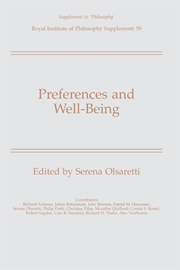Book contents
- Frontmatter
- Contents
- List of Contributors
- “Introduction”
- “Desire Formation and Human Good”
- “Preference Formation and Personal Good”
- “Leading a Life of One's Own: On Well-Being and Narrative Autonomy”
- “Well-Being, Adaptation and Human Limitations”
- “Consequentialism and Preference Formation in Economics and Game Theory”
- “Preferences, Deliberation and Satisfaction”
- “Content-Related and Attitude-Related Reasons for Preferences”
- “Reasoning with Preferences?”
- “Taking Unconsidered Preferences Seriously”
- “Preferences, Paternalism, and Liberty”
- “Preference Change and Interpersonal Comparisons of Welfare”
“Content-Related and Attitude-Related Reasons for Preferences”
Published online by Cambridge University Press: 07 May 2010
- Frontmatter
- Contents
- List of Contributors
- “Introduction”
- “Desire Formation and Human Good”
- “Preference Formation and Personal Good”
- “Leading a Life of One's Own: On Well-Being and Narrative Autonomy”
- “Well-Being, Adaptation and Human Limitations”
- “Consequentialism and Preference Formation in Economics and Game Theory”
- “Preferences, Deliberation and Satisfaction”
- “Content-Related and Attitude-Related Reasons for Preferences”
- “Reasoning with Preferences?”
- “Taking Unconsidered Preferences Seriously”
- “Preferences, Paternalism, and Liberty”
- “Preference Change and Interpersonal Comparisons of Welfare”
Summary
In the first section of this paper I draw, on a purely conceptual level, a distinction between two kinds of reasons: content-related and attitude-related reasons. The established view is that, in the case of the attitude of believing something, there are no attitude-related reasons. I look at some arguments intended to establish this claim in the second section with an eye to whether these argument could be generalized to cover the case of preferences as well. In the third section I argue against such generalizations and present a case in favour of accepting attitude-related reasons for preferences. In the fourth section I present an objection to which I react in the fifth section where I try to strengthen my case for attitude-related reasons for preferences. Finally, I discuss and reject criticisms raised by two opponents of the view defended here.
The Distinction
Think of any attitude we might have towards some proposition p, which, because we have some attitude towards it, I call the content of this attitude. It might be an epistemic attitude like belief or doubt, an attitude like desiring or intending, or an emotional attitude like anger or gratefulness. For all these attitudes we can have reasons that speak in favour of or against adopting them. On a conceptual level we can distinguish between two kinds of reasons. Content-related reasons are such that, if we are aware of them, they show us p, the content of an attitude, in a certain light.
- Type
- Chapter
- Information
- Preferences and Well-Being , pp. 155 - 182Publisher: Cambridge University PressPrint publication year: 2006
- 2
- Cited by



